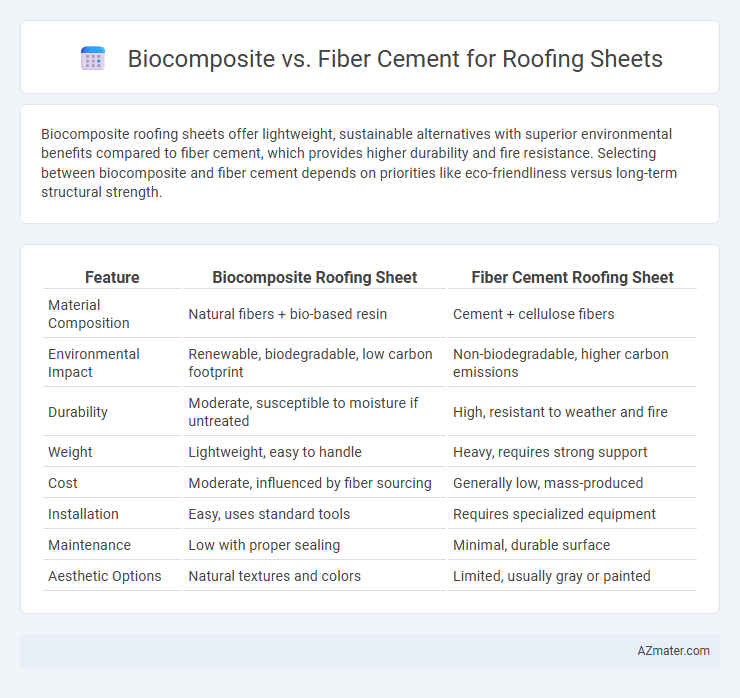Biocomposite roofing sheets offer lightweight, sustainable alternatives with superior environmental benefits compared to fiber cement, which provides higher durability and fire resistance. Selecting between biocomposite and fiber cement depends on priorities like eco-friendliness versus long-term structural strength.
Table of Comparison
| Feature | Biocomposite Roofing Sheet | Fiber Cement Roofing Sheet |
|---|---|---|
| Material Composition | Natural fibers + bio-based resin | Cement + cellulose fibers |
| Environmental Impact | Renewable, biodegradable, low carbon footprint | Non-biodegradable, higher carbon emissions |
| Durability | Moderate, susceptible to moisture if untreated | High, resistant to weather and fire |
| Weight | Lightweight, easy to handle | Heavy, requires strong support |
| Cost | Moderate, influenced by fiber sourcing | Generally low, mass-produced |
| Installation | Easy, uses standard tools | Requires specialized equipment |
| Maintenance | Low with proper sealing | Minimal, durable surface |
| Aesthetic Options | Natural textures and colors | Limited, usually gray or painted |
Introduction to Roofing Sheet Materials
Biocomposite roofing sheets combine natural fibers such as hemp, flax, or wood with resin matrices, offering eco-friendly, lightweight, and sustainable alternatives to traditional materials. Fiber cement roofing sheets consist of cement reinforced with cellulose fibers, delivering high durability, fire resistance, and low maintenance. Both materials serve as modern roofing solutions, with biocomposites emphasizing environmental benefits and fiber cement prioritizing strength and longevity.
What Are Biocomposites?
Biocomposites are eco-friendly roofing materials made from natural fibers such as hemp, flax, or wood combined with biodegradable or recyclable polymers. These materials offer lightweight, high durability, and excellent thermal insulation, making them a sustainable alternative to traditional fiber cement roofing sheets. Compared to fiber cement, biocomposites provide improved environmental benefits by reducing carbon footprint and supporting renewable resource use in construction.
Understanding Fiber Cement Sheets
Fiber cement sheets, composed of cement reinforced with cellulose fibers, offer exceptional durability, fire resistance, and low maintenance, making them ideal for roofing sheets in harsh weather conditions. Their non-combustible nature and resistance to termites and rot provide long-lasting protection compared to traditional roofing materials. Fiber cement roofing sheets balance strength and cost-effectiveness, providing a sustainable alternative with enhanced structural integrity and environmental benefits.
Key Material Properties Compared
Biocomposite roofing sheets typically feature natural fibers combined with bio-based resins, offering high tensile strength, flexibility, and eco-friendliness, while fiber cement sheets consist of cementitious materials reinforced with inorganic fibers, enhancing fire resistance and durability. Biocomposites provide superior biodegradability and lower thermal conductivity, promoting energy efficiency, whereas fiber cement excels in resistance to moisture, rot, and insect damage. The choice between biocomposite and fiber cement roofing depends on priorities such as environmental impact, mechanical strength, and longevity under specific climatic conditions.
Environmental Impact: Biocomposite vs Fiber Cement
Biocomposite roofing sheets offer a significantly lower environmental impact compared to fiber cement due to their use of renewable natural fibers and biodegradable resins, which reduce carbon footprint and landfill waste. Fiber cement production involves high energy consumption and emits substantial CO2, contributing to environmental pollution and resource depletion. The biodegradability and sustainable sourcing of biocomposites make them a greener alternative for eco-conscious roofing solutions.
Durability and Lifespan Analysis
Biocomposite roofing sheets offer moderate durability with resistance to moisture and UV exposure, typically lasting 15-25 years depending on maintenance and environmental conditions. Fiber cement roofing sheets demonstrate superior durability, resisting fire, rot, and pests, and can achieve a lifespan of 30-50 years with minimal upkeep. The enhanced lifespan of fiber cement materials makes them a preferred choice for long-term roofing solutions in harsh climates.
Cost Comparison for Roofing Projects
Biocomposite roofing sheets generally offer a lower upfront cost compared to fiber cement options, making them attractive for budget-sensitive roofing projects. Fiber cement roofing sheets have higher durability and require less frequent maintenance, which can result in lower long-term expenses despite the higher initial investment. Cost efficiency in roofing projects depends on balancing the initial material price with factors such as lifespan, maintenance frequency, and environmental conditions.
Installation and Maintenance Factors
Biocomposite roofing sheets offer lightweight installation with reduced labor due to their ease of handling compared to fiber cement, which tends to be heavier and more brittle, requiring specialized tools and careful positioning. Maintenance for biocomposites typically involves minimal upkeep, as they resist corrosion, mold, and UV degradation, while fiber cement sheets need regular inspections for cracks and water damage due to their porous nature. The choice between these materials hinges on desired durability, installation efficiency, and long-term maintenance costs, with biocomposites providing a greener alternative with simpler service requirements.
Safety and Health Considerations
Biocomposite roofing sheets offer improved safety by being free from harmful chemicals and asbestos, reducing health risks such as respiratory issues commonly associated with fiber cement materials. Fiber cement sheets, while durable, may release silica dust during cutting or installation, necessitating protective measures like masks and ventilation to prevent long-term health problems. Biocomposites also provide better biodegradability and lower environmental impact, supporting healthier indoor air quality compared to fiber cement alternatives.
Choosing the Best Material for Your Roof
Biocomposite roofing sheets offer eco-friendly benefits with renewable natural fibers and improved insulation, reducing environmental impact and energy costs. Fiber cement sheets provide superior durability, fire resistance, and moisture tolerance, ideal for long-lasting structural performance in diverse climates. Selecting the best material depends on prioritizing sustainability and thermal efficiency with biocomposites or opting for fiber cement's strength and weather resilience for roof longevity.

Infographic: Biocomposite vs Fiber Cement for Roofing Sheet
 azmater.com
azmater.com